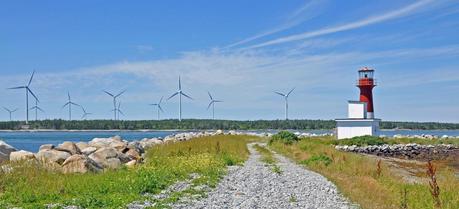 The development of a wind farm is a process in which various factors need to be taken into consideration. On the photo: On the photo: A wind farm on the southern portion of Pubnico Point, Nova Scotia, Canada. (Credit: Flickr @ Dennis Jarvis https://www.flickr.com/photos/archer10/)
The development of a wind farm is a process in which various factors need to be taken into consideration. On the photo: On the photo: A wind farm on the southern portion of Pubnico Point, Nova Scotia, Canada. (Credit: Flickr @ Dennis Jarvis https://www.flickr.com/photos/archer10/)The Sopcawind tool, a piece of software that facilitates the design of wind farms, was recently presented at the EWEA 2014 Annual Event in Barcelona.
The development of a wind farm is a process in which various factors need to be taken into consideration to ensure that the resource is properly used and that appropriate planning is carried out to minimize the effects it could have.
SEE ALSO: Scientists Determine Most Favorable Wind Turbine Positioning
The Sopcawind tool takes into account not only the aspects of energy productivity but also the possible impact the wind farm may have on the environment, radars or other telecommunications systems in the vicinity. It also assesses acoustic noise, the effect of shadow on nearby housing, and applies criteria for heritage protection or clearance from transport networks and certain facilities.
“The fundamental parameter to take into account when designing a wind farm is the wind or wind potential. Another very important factor is the orography of the land,” explained David de la Vega, a member of the Signal Processing and Radiocommunications Group (TSR).
“Apart from these two main factors, the environmental factor and perhaps not such obvious factors like the telecommunications services (weather radars, air traffic control radars, radionavigation aids, television, data radio links, etc.) are also important,” added la Vega. What happens in many cases is that the telecommunications service may not located next to the farm, and “although interference is not common, a wind farm can alter a radar signal that is 10-20 kilometers away,” stressed researcher.
Thanks to the European SOPCAWIND project, the TSR group at the University of the Basque Country (UPV/EHU) is developing the tool that integrates into a single application a complex, multidisciplinary database that accommodates all the data needed for the above-mentioned criteria, apart from the algorithms needed to carry out these studies. With all these functions, the Sopcawind tool facilitates the design work of the wind farm developer and makes it possible to ensure that all the above-mentioned aspects are taken into consideration in the wind farm design process, thus avoiding any trouble. “Thanks to this tool, firstly the design process of the wind farm is much more fluid, and secondly, the developer knows in advance if there is any trouble and can include modifications in the wind farm in order to avoid it, which is a key aspect,” pointed out Daniel de la Vega.
“We have developed the algorithms to find out the impact caused by wind farms on telecommunications systems (TV, data radio links, radars and air navigation aids) and we have incorporated them into the tool,” explained de la Vega.
“Because these impact studies are conducted before the wind farm is built, they allow potential interference to be detected if it does in fact exist, and so the wind farm developer will be able to include modifications in the design of the wind farm in order to prevent that trouble,” de la Vega pointed out. That way, the impact studies allow the wind energy to be developed without degrading the existing telecommunications systems.

